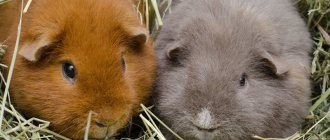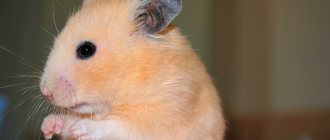The Doberman is an incredibly graceful, strong and fearless representative of the breed of protective dogs.
At the same time, the animal is distinguished by a sharp mind, is easy to train and is infinitely devoted to its owner. These dogs are also good with children.
The dream of any owner is for his pet to live a long and happy life.
Let's look at what factors influence the length and quality of life of a Doberman.
How old do Dobermans grow?
The age of maturity when a dog stops growing is 2 years for Doberman Pinschers. Some individuals grow longer, others are considered accelerators due to faster growth.
Growth spurts in dogs occur up to 6 months, then there is active development of the peripheral skeleton, paws and ears. The puppies' bodies take on a slightly awkward appearance. Closer to the year, the dog's skeleton is almost formed. Until 2 years of age, the slow development of the animal’s body and head continues.
For some dog breeders, the question of how many years a breed takes to form remains open. Experts say that delayed development continues not until 2, but up to 3 years.
Differences in the period of residence at home and on the street
Dobermans can be kept both indoors and outdoors. In the first case, the dog develops a more stable psyche, since the animal does not experience stress due to loneliness or lack of attention. In addition, your pet's risk of colds is reduced.
Street maintenance is also possible. To prevent it from causing a shortening of the Doberman's life, it is important to follow some rules. Firstly, you need to purchase or build yourself a fairly spacious enclosure and a booth, the size of which should not hinder the movements of the Doberman. The dog's home should be insulated; in winter, it is ideal to provide heated floors and walls.
You need to make sure that your pet always has all the necessary things freely available: toys, treats, water and food. Also, despite the dog’s constant presence outside in an enclosure, it is required to walk it daily and play with it, giving it the opportunity to get rid of accumulated energy. Otherwise, the risk of your pet losing activity, developing mental disorders, obesity and other diseases increases.
What affects life expectancy?
Even factors such as castration or sterilization affect how long a pet will live. Today, raising purebred puppies is quite difficult and expensive. But the health of the individual in the future depends on the nutrition and care of the animal in childhood.
Proper nutrition
Veterinarians advise breeders of the breed not to mix natural and ready-made food. You should not mix dry and wet factory-produced food with each other. The dog’s feeding style is chosen immediately as soon as the puppy gets into the house.
It is worth remembering that due to the characteristics of the stomach, representatives of the breed are not fed soups. They need thick food.
The Doberman's menu changes every year depending on his developmental needs.
About 800 grams of meat per day, approximately 700 grams of cereals, up to 300 grams of cottage cheese, 200 grams of vegetables and the same amount of dairy products - this is the approximate daily diet of a growing puppy. Neither a puppy nor an adult dog should be given smoked meats, sauces, pickles, processed foods and sweets. For a Doberman, such food is poison.
Maintenance and care
Caring for a Doberman is quite simple. The dog is brushed once every 7 days. Some owners wipe their pets with towels every morning. You can bathe your four-legged friend once every six months. But the dog’s eyes and nose need to be wiped with a cotton swab dipped in water every day. The Doberman's ears are cleaned a couple of times a week using special drops and cotton swabs. The longer a pet walks outside, the stronger its health.
Physical activity
Walking and walking are two different concepts among dog breeders that are often confused. Walking means 10-20 minutes outside to relieve natural needs. You can walk a female in 10 minutes, a male in 20 minutes.
A walk with a dog takes 1.5-2 hours. At this time, the animal moves without a leash in a safe area. It is during the walk that training sessions and active games are held. According to sanitary and hygienic standards, the domestic Doberman must have a long walk every day.
Castration and sterilization
It is believed that spayed or neutered individuals live almost as long as non-surgical animals. It is believed that spaying can save a female dog from certain types of cancer. But this issue has not yet been fully studied.
Neutered males live longer because they show less aggression and get into fights. To prevent the dog from gaining weight after the operation, its diet is strictly monitored, observing the daily food intake.
Proper nutrition
Dobermann can be fed dry food or a natural diet.
Pay attention to what the puppy ate before you purchased it and follow the breeder's feeding schedule, because... A sudden change in diet can harm the baby.
Under no circumstances should you mix dry and natural food, as this can cause irreparable damage to your pet’s digestive system.
When choosing a natural diet, adhere to the following feeding rules:
- Offer your pet a balanced, varied and vitamin-rich diet;
- develop a certain eating regimen and follow it;
- Doberman's food should be thick, soups are not suitable for him;
- With increasing physical activity and pregnant (nursing) bitches, it is necessary to increase the volume of meat portions.
Products necessary for the full development and longevity of the Doberman:
- meat (beef, lamb, veal, chicken) and fish - 600-800 g per day;
- porridge (buckwheat, rice, oatmeal) - 500-700 g per day;
- cottage cheese up to 300 g;
- fermented milk products up to 200 g;
- fresh vegetables and fruits - 200 g.
Any smoked meats, fatty meats, sausages, pasta, potatoes, bread, legumes and generally food from the “master’s table” should be excluded from the dog’s diet.
How to find out the age of a Doberman?
A dog's busy life is cyclical. Doberman Pinschers don't live long if they don't receive proper care. The age of a puppy of the breed can be approximately determined by weight, as well as height at the withers. Although these factors may be affected by some disease, and the dog will be smaller than necessary for its age. Let's consider the ideal ratio of height and weight of a well-groomed puppy:
| Weight | Height | Approximate age |
| 3.5 kg | 25 cm | 1 month |
| 12 kg | 44 cm | 3 months |
| 24 kg | 65 cm | 6 months |
| 27 kg | 72 cm | 9 months |
| 35 kg | 80 cm | 12 months |
By simple calculations you can determine the dog's age using the table. When a breeder wants to know more accurate information about a puppy found or purchased, he contacts a veterinarian. A specialist can determine a dog’s age by its teeth and other body parameters.
Need for physical activity
Dobermans are energetic creatures. They need long walks, jogging, and active games. Without this, the dog's lifespan will be significantly reduced.
If, for one reason or another, the dog has not received physical activity, it is necessary to accustom him to it gradually, increasing the duration of the walk over and over again. The optimal time is 1.5 hours.
Comparison table with human years
Dobermans began to gain people's attention in the 19th century. Those who are seriously interested in the breed ask: “How long do Dobermanns live by human standards?” This information is no secret:
| Dog age | Similar age person |
| 1 year | 14 years |
| 2 years | 24 years |
| 5 years | 40 years |
| 10 years | 65 years old |
| 12 years | 75 years old |
| 15 years | 87 years old |
| 16 years | 90 or more |
If you feed and raise a dog correctly, then pets of this breed live quite a long time. Comparing human age and dog age is relative.
Life expectancy for boys and girls
Males live from 12 to 15 years. Females of the breed live longer, sometimes living up to a record 16 years.
There is an opinion that Dobermans are not long-lived, but this is not entirely true. When a dog is in good conditions, its chances of living to an old age are no less than those of other breeds.
The world knows many miraculous cases when, even with a history of serious illnesses, a pet lived to an old age thanks to the efforts of its owners.
Life expectancy of a Miniature Pinscher (Dwarf Doberman)
Relatives of the large and strong Dobermans, Miniature Pinschers can live for about 14 years. The average lifespan of the new breed of dwarf Dobermans is 10-12 years.
Interesting to know! “An interesting observation was made by breeders when they discovered that pointy-faced breeds lived slightly longer than flat-faced members of the animal kingdom.”
An active pinscher will live longer than a lazy and overweight fellow due to the diseases associated with obesity. It must be remembered that proper feeding is the key to a dog’s longevity.
Origin story
The origin story is somewhat vague. The breeding of the Doberman Pinscher dog breed was carried out by a versatile public figure - Friedrich Louis Dobermann. He needed a companion who could perform police functions.
Friedrich Dobermann did not keep complete records of the breeding process. The roots of this breed are revealed only by logic and knowledge of those breeds that were common in Germany. It has been established that Doberman began breeding a new breed in the 1880s; experts can only guess about the ancestors of the breed. They agree that the following were used to develop the Doberman Pinscher breed:
- Ancestors of the Old German Pinschers;
- Herding dogs – shepherd dogs;
- Butcher dogs;
- Hunting shorthaired pointers.
It is believed that the Doberman breed crossed paths with the Manchester Black and Tan Terriers, Blue Great Danes, Mastiffs and others.
Diseases of the breed
What should you look for in your pet’s behavior to understand that he is sick?
A hot nose, refusal to eat, restless behavior, or a constant desire to lie down are the first symptoms of many pet diseases.
Unfortunately, Dobermans are susceptible to oncology, cardiovascular diseases, bloating, thyroid problems, cervical syndrome, narcolepsy, and obesity. Because of these ailments, they live less than what nature intended for them.
Caring for an older dog
Caring for an old Doberman does not require excessive effort, the main thing is to understand that it requires only a little more of your attention, care and compliance with the following small rules:
- Offer your pet high-quality food in the required quantities, focusing on white meat (rabbit, chicken, fish), because many older dogs have kidney problems;
- Make sure that the water bowl is always full, it is necessary to maintain the balance of fluid in the dog’s body;
- keep your pet’s home and body clean;
- do not overuse active games and do not jerk your pet over trifles.
Every owner worries that his pet may die early, especially knowing about all sorts of pathologies and diseases inherent in the breed.
Nevertheless, it is in your power to protect your pet from dangers, prevent the onset of the disease in time and prolong its happy years of life with high-quality care.
Signs of aging
The first sign of aging is the animal's changing color. The appearance of gray or silvery hairs indicates the beginning of the decline of the body.
The breed description contains information about the condition of the young animal's coat. It should be shiny and smooth. An old dog loses its shine, moves little, eats less, and develops dental problems.
The main sign of the onset of old age is not age, but the dull eyes of a pet without the former playful sparkle. Representatives of the breed live long if provided with sufficient physical activity. In old age, they can no longer walk for long periods of time; some individuals develop shortness of breath from climbing stairs.
How to increase the lifespan of a Doberman?
A loving owner wants his four-legged friend to live as long as possible. If a puppy was born without pathology, its life expectancy can be increased in several ways. Dobermans live long if:
- eat well;
- move a lot;
- receive medical care on time;
- vaccinated according to schedule;
- take vitamins;
- receive positive emotions;
- avoid dangerous situations;
- develop through training.
The peculiarity of these rules is their simplicity and effectiveness. The love of the owner and the devotion of the pet can work wonders. These factors are the most important regarding prolonging the life of a dog.
The Doberman breed has gained popularity not because of how long the dogs live, but because of their watchdog qualities. In the 19th and 20th centuries in Germany, pinschers served in the police and protected private houses from burglars. The history of the formation of Dobermans is shrouded in mystery, since no detailed records on this topic have been preserved. Therefore, conclusions about what a proper Doberman should look like have been made by modern breeders.
Health
This is a healthy breed, but not a single dog is immune from genetic diseases.
In addition, Dobermans are predisposed to:
- cardiomyopathy (dangerous due to the impossibility of diagnosis at the initial stage);
- volvulus, torsion and other diseases of the gastrointestinal tract (more often manifested in males in the 4th–7th year of life);
- cancer (females are at risk, since tumors often develop in the mammary glands);
- mental hereditary disorders (therefore it is important to look at the tests of the puppy’s parents).
It is easier to treat any disease at an early stage. In this regard, you need to take your dog for periodic veterinary examinations. Vaccinations play a big role in maintaining the health of the Doberman. An individual vaccination schedule for a dog during puppyhood is drawn up by a veterinarian. In the future, the adult dog is revaccinated annually.
Important! A week before vaccination, the dog needs to be dewormed and treated for ticks and fleas.
Long-lived Dobermans
Among any breed there are some representatives who live longer than others. Among such dogs, long-livers include those who have lived for more than 10 years.
The death of an animal at the age of five is considered premature. The character of a long-liver in a canine environment is always calm. Exterior characteristics and health indicators are excellent. Lean, fast, dexterous and agile - these are the parameters by which you can determine a potential long-liver.
Dobermans were not included in the Guinness Book of Records for life expectancy. But they got caught for their ingenuity and intelligence, like one of the fastest-thinking dogs. Throughout the history of these dogs, only a few out of thousands lived to be 16 years old.
Causes of premature death
Scientists have established several reasons for the premature death of “dobies”:
- Bloating. With this pathological condition, the dog’s stomach fills with gas and compresses the walls of blood vessels, which disrupts the normal blood supply to the digestive tract. “Unnecessary” blood goes back to the heart: cells deprived of nutrition die, toxins enter the bloodstream. If the dog is not helped in time, death may occur within a few hours.
- Hip dysplasia. A congenital malformation of the joint, leading to arthritis, lameness and other problems when walking.
- Wobbler syndrome. The condition is associated with malformations of the spinal column. Pathology makes itself felt with an unsteady gait.
- Von Willebrand's disease. A pathological incurable condition characteristic of Dobermans. The main danger is low blood clotting. A small cut or abrasion results in prolonged bleeding. If you are ill, sudden bleeding from the nose or throat is possible. If the dog is not helped in time, it may die from severe blood loss.
- Chronic hepatitis. A progressive disease affecting the liver. Without proper treatment, the disease destroys this vital organ.
- Dilated cardiomyopathy. A disease in which the heart enlarges to an unnatural size, preventing it from pumping blood normally. Without timely intervention and treatment, the pathological condition develops into chronic heart failure.
It is important to screen for hereditary pathologies before purchasing a puppy:
Briefly about the main thing
To summarize, let’s consolidate the points that are worth knowing about Doberman dogs. The most important thing here is this:
- Animals at home live a long time with good care and quality nutrition.
- The average lifespan of a dog is 12-14 years.
- Many individuals live only up to 10 years due to a genetic predisposition to certain ailments.
- Bitches live several years longer than males.
- Signs of an aging dog begin with changes in color and low mobility.
- You can extend the life of Dobermans with good care.
- There are almost no long-livers among Dobermans.
- You can tell a dog's age by its weight, height or teeth.
- Castrated and sterilized animals live about the same as those participating in breeding.
- Today the breed has a small distribution and a tendency to degeneration.
Offspring
The popularity of the breed gave rise to many mixed breeds. If you want to buy a purebred Energizer, then contact professional nurseries, where they will provide the pedigrees of the parents. In addition, among Russian aristocrats there are a large number of champions of international European exhibitions.
How to choose a puppy
The breed standard was recently changed for height, reducing the permissible height. Therefore, if you strive for prize medals, then do not chase the big puppies. If the height is 1 cm higher, the skull is apple-shaped, short legs, excessive excitability or aggressiveness, the dog is not allowed into the ring. European judges disqualify docked specimens. Naturalness is encouraged.
Before choosing a strong baby aristocrat, pay attention to the health of the bitch, on which 70% of the viability of miniatures depends. The mother’s nervous system affects the development of the fetus, the amount of milk, and the fullness of lactation.
Therefore, pay attention to the mother's reaction when strangers appear. Excessive aggression is a bad indicator.
Please note that if the puppy’s ears have not “stood up” by the age of 4 months, then you will have to repeatedly apply special bandages-plasters to get protruding ears. But someone may be lucky and the ears will rise on their own at 6 months.
How much does a miniature pinscher cost?
Today, the price of miniature pinscher puppies varies from 10,000 to 30,000 rubles. If the doggies are sold at a lower price, it means they have no pedigree or are out of breeding stock.
Purebred healthy puppies with all the necessary documents, but without obvious exhibition prospects, cost from 10,000 to 20,000 rubles. The offspring of champion parents, for whom breeders predict a brilliant exhibition career, will cost more.
Mating
Breeding mini pinschers involves fewer risks and difficulties compared to Yorkshire terriers and toy terriers. The bitches are healthier, the babies are stronger. If the girl’s dimensions are at the lower limit of the standard, then it will be difficult for her to bear and give birth to offspring. The dog chosen for breeding is not too large, ideally an experienced one.
Although clubs allow mating during the second heat, it is better not to rush and wait for the third
The mother’s bones will have time to strengthen and will not lose the vital calcium depot used for the development of the fetus. The interval between matings is not reduced to a period of less than a year.
The maximum age of the first birth is 4 years, the last - 8-9 years.
Mated on days 8-13 of estrus only in the male's territory. Usually everything goes naturally. The date is repeated every other day, increasing the chances of pregnancy. Pregnancy, as a rule, proceeds without complications. In the first month, mommy is lethargic, barely eats, and is capricious. You can't force feed. It is permissible to pamper with healthy treats and vitamins.
In the second month, the risk of severe obesity in the female increases, which is dangerous for babies. The mother is transferred to food for puppy bitches, but is not overfed. Take him for walks more often, giving him the opportunity to urinate more often.
Before giving birth, the mother's temperature drops to 37.4 degrees, the water breaks and the girl looks for a secluded place. By this time, a box, clean diapers, antiseptics, scissors, and water should be ready for childbirth. If labor is prolonged, call a veterinarian at home.











